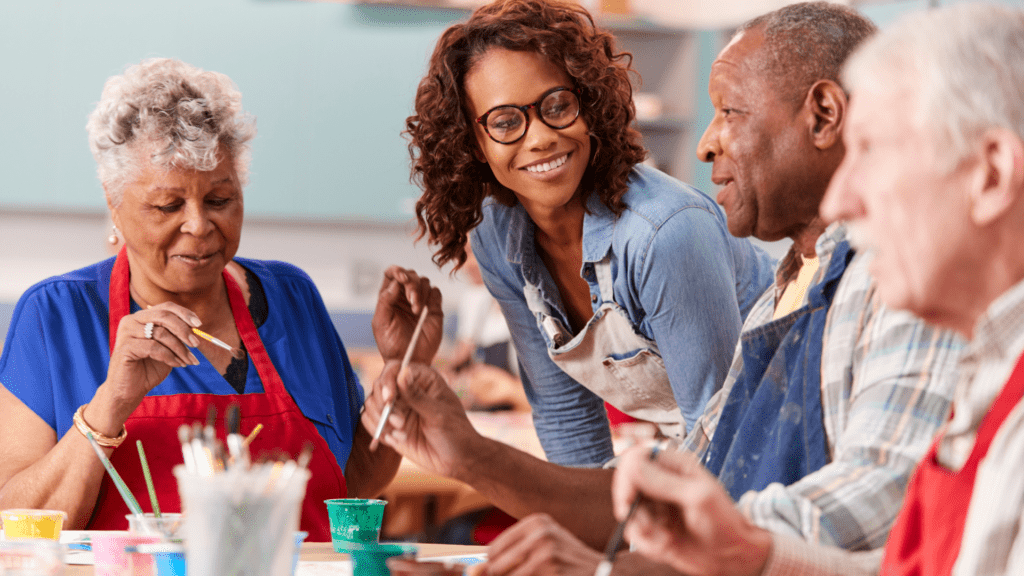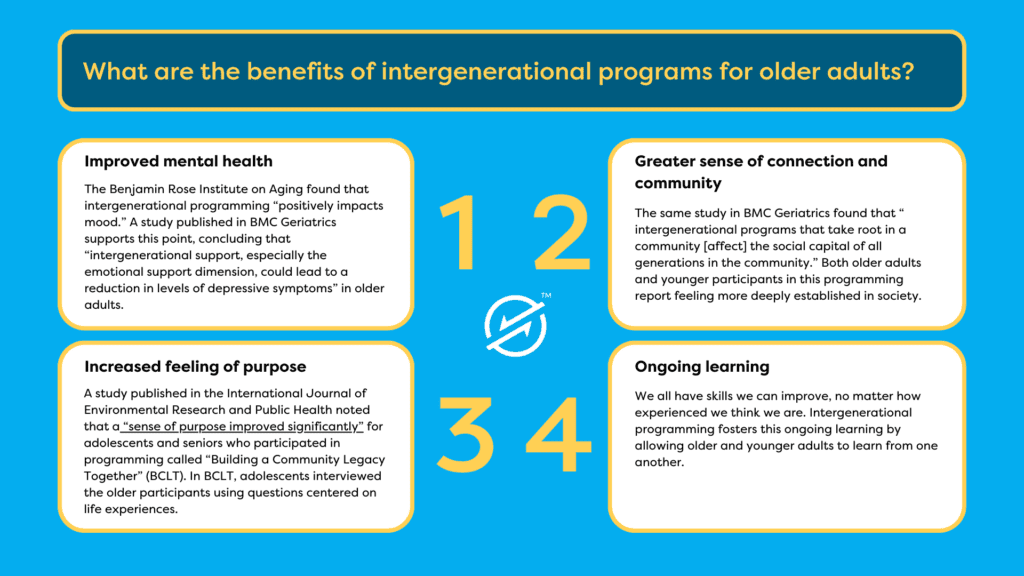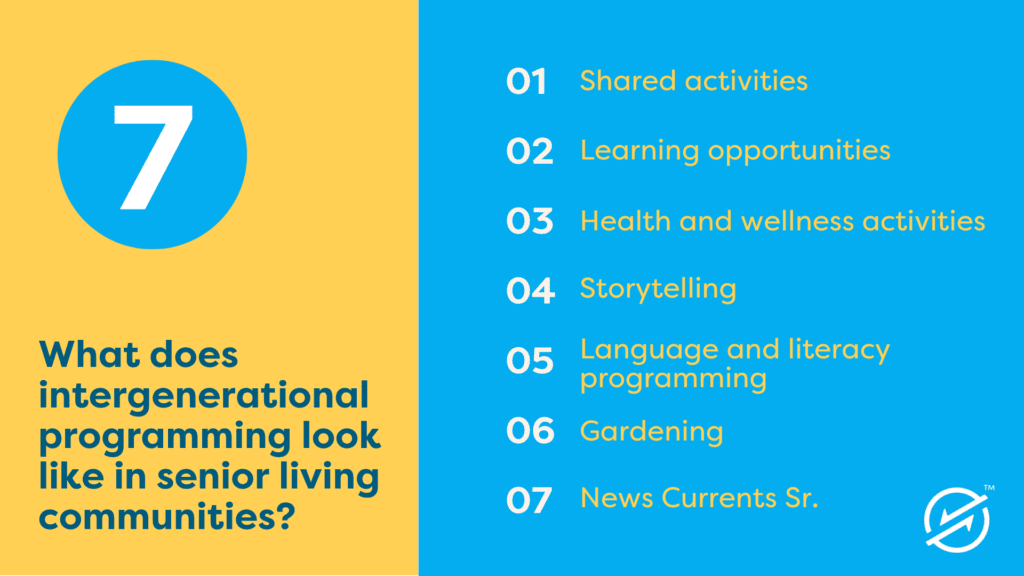
From Baby Boomers to Millenials to Gen Z, every generation shares significant historical experiences that set it apart from individuals outside its cohort. While Baby Boomers witnessed the civil rights movement, the assassination of a president, and the first moon landing, members of Gen Z have never lived in a world without the internet. They are coming of age in a completely different world, one run by smartphones and social media.
How, then, do people who grew up in vastly different times find ways to connect? And what is the value of that connection?
Intergenerational programming in senior living communities can bridge these age gaps by providing opportunities for engagement, storytelling, and collaboration. These programs have proven beneficial not only for older adults but also for their younger counterparts.
What is intergenerational programming?
The National Council on Aging defines intergenerational programming as any strategically designed events or activities that bring together individuals from two or more generations with the intent to counter ageist stereotypes, identify shared values, relate stories, form connection and community, and pass on knowledge.
Emerging as a field of study for the past 40 years, intergenerational initiatives are now popular studies in scientific literature thanks to EH Erikson’s “lifespan approach,” which is “based on the view that relationships between children and older people bring benefits for both” due to parallel developmental needs.
In fact, there’s a non-profit organization called Generations United that works to foster intergenerational collaboration. They’ve found that “older volunteers in intergenerational programs report a stronger sense of community, decrease in social isolation, improvements in quality of life, greater life satisfaction, and a stronger sense of purpose, self-worth, self-esteem, and empowerment.”
What are the benefits of intergenerational programs for older adults?

Increased attention to the field of intergenerational programming has enabled myriad scientific studies that document the beneficial outcomes for participants. These studies have helped researchers draw meaningful conclusions about the programming’s value and impact.
- Improved mental health. The Benjamin Rose Institute on Aging found that intergenerational programming “positively impacts mood.” A study published in BMC Geriatrics supports this point, concluding that “intergenerational support, especially the emotional support dimension, could lead to a reduction in levels of depressive symptoms” in older adults.
- Greater sense of connection and community. The same study in BMC Geriatrics found that “ intergenerational programs that take root in a community [affect] the social capital of all generations in the community.” Both older adults and younger participants in this programming report feeling more deeply established in society.
- Increased feeling of purpose. A study published in the International Journal of Environmental Research and Public Health noted that a “sense of purpose improved significantly” for adolescents and seniors who participated in programming called “Building a Community Legacy Together” (BCLT). In BCLT, adolescents interviewed the older participants using questions centered on life experiences.
- Ongoing learning. We all have skills we can improve, no matter how experienced we think we are. Intergenerational programming fosters this ongoing learning by allowing older and younger adults to learn from one another. For example, younger adults may help older adults learn how to improve their digital literacy, while older adults may share firsthand accounts of what it was like to live in certain historical moments that have significantly impacted our current culture, such as the March on Washington when MLK delivered his “I Have a Dream” speech, or the death of Princess Diana.
What are the benefits of intergenerational programs for older adults?

Intergenerational programming in senior living communities takes a variety of forms and should be shaped by feedback from the community members. Typically, this programming may look like:
- Shared activities. These can take a variety of forms: building Legos, working on a puzzle, solving brain teasers, playing a board game, making jewelry, etc.
- Learning opportunities. This type of programming invites each member of different generations to learn from one another. They may conduct an interview, as though they’re a journalist preparing to write a profile, or they may simply have a conversation centered around a theme, such as holiday traditions, favorite family foods, and school classes. The purpose is to transmit cultural knowledge, connect over shared values, and build bridges across age differences.
- Health and wellness activities. Fitness classes and wellness workshops that apply to all age groups can be a fun way to get people up and moving. A ballroom dancing class, water aerobics, or even Zumba can get everyone laughing and enjoying the moment.
- Storytelling. Older adults can share the historical events they’ve lived through, providing a “living history lesson” to those who may not have been born at the time.
- Language and literacy programming. Younger people can practice their reading and language skills by reading aloud with help from older adults.
- Gardening. Together, different generations can create a community garden they tend together.
- News Currents Sr. This current events discussion resource invites members of different generations to learn about and share their views on current world news. With regular features such as “This Week in History” and “Who am I?”, older and younger adults can work together to revisit the past, answer engaging questions, study photographs of beautiful places to travel, and test their geography knowledge. With a new issue every week, there’s always something to talk about!
Get Talking!
Intergenerational programming in senior living communities takes a variety of forms and should be shaped by feedback from the community members. Typically, this programming may look like:
For older adults, intergenerational programming can play a pivotal role in feeling connected within a community. This kind of programming builds social networks, improves mental health, and boosts self-worth and self-esteem. The benefits extend across age groups, from improving dietary and nutrition habits to enhancing mood awareness and learning new material. By engaging in these programs, older adults can experience improved self-confidence, civic engagement, and sharper problem-solving skills, supporting their wellness and building stronger communities.